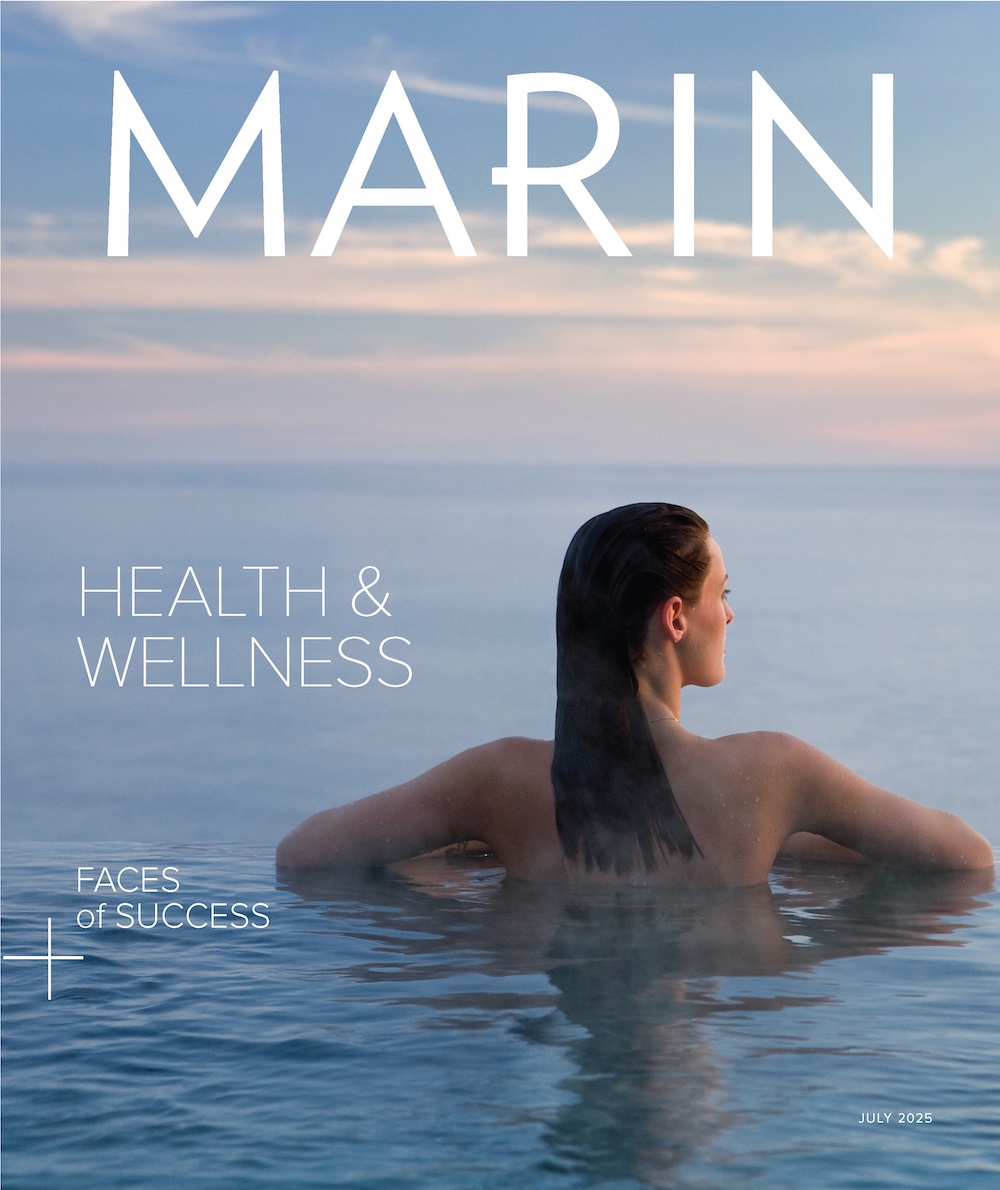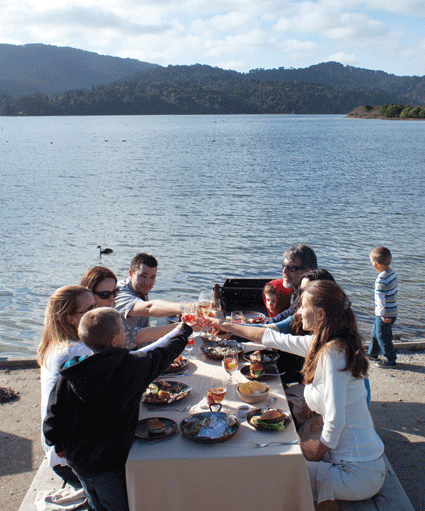WHILE CREATING AN ideal, oyster-filled family picnic in West Marin can seem like a breeze for a professional chef, the rest of us might panic not only at the thought of the shucking process but also the question of how to complement the dish. So we enlisted chef Justin Everett of Murray Circle at Cavallo Point to share a few of his tried-and-true tips.
Everett hosted his first West Marin oyster picnic last summer. He and his friends and family showed up outside the Tomales Bay Oyster Co. around 11 a.m. “The place was humming with a great cultural mix of people preparing different types of food and enjoying the beautiful day,” he says. “The Tomales Bay Oyster Co. makes it easy. Besides the tables and barbecues, they have everything you need to enjoy oysters: oyster knives, lemons, limes, hot sauce, charcoal and ice.” But the most important ingredient for a successful day, he notes, is the timing. “Get in early and get a good table,” he says. “To be on the safe side, you might want to call ahead for availability, but usually you can just pull up and get what you need.”
For his guests who don’t want oysters, Everett prepares a few burgers ahead of time using ground meat from Sun Farms, located just south of Point Reyes Station. Everett brings salt and fresh ground pepper to add to the burger. As for the oysters, Everett makes all of the accompanying marinades, dips and salads the day before. He notes that not only is this easier to plan, but the food tastes “one thousand times better.”
How to Shuck an Oyster
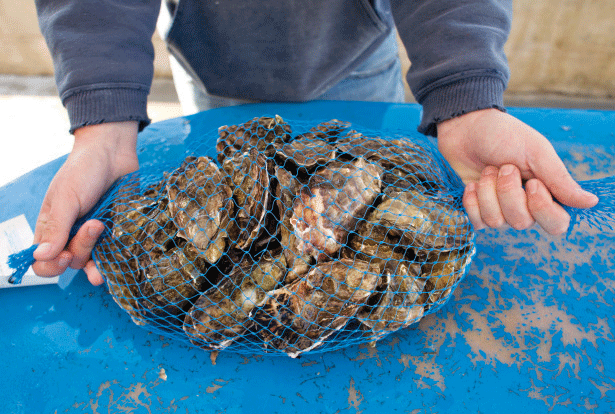 Murray Circle executive chef Justin Everett offers these tips. First and foremost is safety. “There is nothing worse than a fun day ruined by having to make a trip to the hospital,” he says. “Especially when trying to teach young kids the craft of oyster shucking, I always suggest wrapping the hand that is not holding the oyster knife in a towel or a glove so if the knife slips it hits the towel or safety glove and not the hand.” Here, Everett’s step-by-step process:
Murray Circle executive chef Justin Everett offers these tips. First and foremost is safety. “There is nothing worse than a fun day ruined by having to make a trip to the hospital,” he says. “Especially when trying to teach young kids the craft of oyster shucking, I always suggest wrapping the hand that is not holding the oyster knife in a towel or a glove so if the knife slips it hits the towel or safety glove and not the hand.” Here, Everett’s step-by-step process:
1) Choose a nice-looking oyster: If it feels too heavy it might be full of mud; if it feels too light it could be dry and might have lost all of its “liquor,” or liquid. Eventually you can tell just by holding them.
2) Every oyster has a bottom (the cup-shaped side of the shell) and a top (flat like a lid). The “hinge” usually comes to a point where the bottom and the “lid” are connected; that’s where you want to place the point of your oyster knife. Wedge the point of your oyster knife into that spot, using the leverage of your whole arm. When pressure is applied to this spot the lid pops open easily.
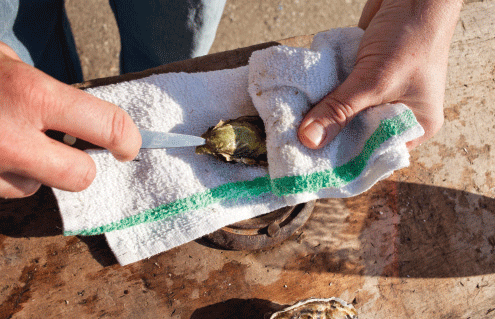 3) The oyster holds on to the top and bottom shell at two points with a very small adductor muscle. Slide the blade of the oyster knife across the inside of the lid and sever the connection to the top shell. The lid can now be discarded.
3) The oyster holds on to the top and bottom shell at two points with a very small adductor muscle. Slide the blade of the oyster knife across the inside of the lid and sever the connection to the top shell. The lid can now be discarded.
4) Slide the blade of the knife underneath the meat to release the oyster from the bottom shell.
5) Inspect the oyster for any shell fragments, and remove if necessary.
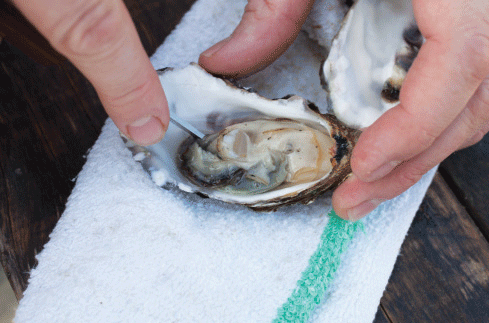 6) To eat, garnish with mignonette, lemon or hot sauce — or just enjoy plain. Put the opposite end of the hinge up to your lips, tilt back the shell, and the oyster should slide easily into your mouth.
6) To eat, garnish with mignonette, lemon or hot sauce — or just enjoy plain. Put the opposite end of the hinge up to your lips, tilt back the shell, and the oyster should slide easily into your mouth.
Accompanying Marinades and Recipes Shared by Chef Justin Everett |
| Apple Jalapeño Mignonette |
| Refreshing Strawberry and Lime Soda |
| Shallot Fondue |
| Salsa Verde |
| Barbecued Rocky Road Brownies |

Mimi Towle has been the editor of Marin Magazine for over a decade. She lived with her family in Sycamore Park and Strawberry and thoroughly enjoyed raising two daughters in the mayhem of Marin’s youth sports; soccer, swim, volleyball, ballet, hip hop, gymnastics and many many hours spent at Miwok Stables. Her community involvements include volunteering at her daughter’s schools, coaching soccer and volleyball (glorified snack mom), being on the board of both Richardson Bay Audubon Center. Currently residing on a floating home in Sausalito, she enjoys all water activity, including learning how to steer a 6-person canoe for the Tamalpais Outrigger Canoe Club. Born and raised in Hawaii, her fondness for the islands has on occasion made its way into the pages of the magazine.
